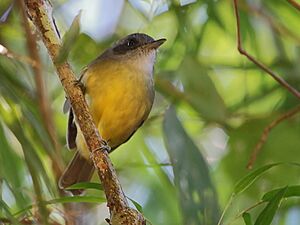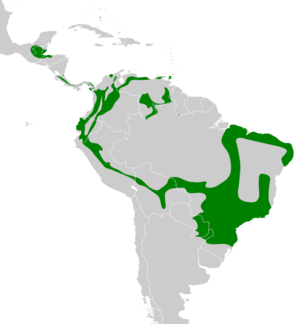Plain antvireo facts for kids
The plain antvireo (Dysithamnus mentalis) is a small passerine bird that belongs to the "typical antbirds" family. It lives in many parts of Mexico, Central America, Trinidad and Tobago, and most countries in South America. This bird is known for its quiet nature and its wide range across different types of forests.
Quick facts for kids Plain antvireo |
|
|---|---|
 |
|
| Male at Jacutinga, Minas Gerais State, Brazil | |
 |
|
| Female at Cordillera del Cóndor, Ecuador | |
| Conservation status | |
| Scientific classification | |
| Genus: |
Dysithamnus
|
| Species: |
mentalis
|
 |
|
Contents
About the Plain Antvireo
Scientific Name and Discovery
Scientists give every living thing a unique scientific name. The plain antvireo was first described by a Dutch zoologist named Coenraad Jacob Temminck in 1823. He gave it the name Myothera mentalis. Later, it was moved to the genus Dysithamnus by a German ornithologist, Jean Cabanis, in 1847. This is how scientists organize different species.
Plain Antvireo Subspecies
The plain antvireo has many different types, called subspecies. There are 18 known subspecies of this bird. Each subspecies might have slight differences in appearance or where they live. Scientists are still studying them to understand how they are related.
- D. m. septentrionalis
- D. m. suffusus
- D. m. extremus
- D. m. semicinereus
- D. m. viridis
- D. m. cumbreanus
- D. m. andrei
- D. m. oberi
- D. m. ptaritepui
- D. m. spodionotus
- D. m. aequatorialis
- D. m. napensis
- D. m. tambillanus
- D. m. olivaceus
- D. m. tavarae
- D. m. emiliae
- D. m. affinis
- D. m. mentalis
Appearance and Characteristics
The plain antvireo is a small bird, usually about 10 to 13 centimeters (4 to 5 inches) long. It weighs between 12 and 16 grams (0.4 to 0.6 ounces). It has a somewhat stocky body with a large head and a short tail.
Male vs. Female Plain Antvireo
Male and female plain antvireos look a bit different.
- Males of the most common type (called the nominate subspecies) have a dark gray head and blackish ear patches. Their upper body is grayish-olive, and they have a hidden white patch on their back. Their wings and tail are dark grayish-olive with white tips on some feathers. Their throat and upper chest are white with light gray spots. Their belly is pale gray with a yellow center.
- Females have a cinnamon-colored crown (top of the head). Their upper body and wings are more olive and less gray than the males'. They do not have the white patch on their back. Their wing feathers have olive-yellow edges. Their underparts have more yellow than the males'.
Subspecies Variations
Different subspecies of the plain antvireo can have slight variations in color. Some males might be grayer or paler, while others have a blackish crown. Females can also vary, with some having warmer brown upper parts or yellower underparts. These small differences help scientists tell them apart.
Where Plain Antvireos Live
The plain antvireo lives in a very wide area, but its distribution is a bit scattered. You can find it in:
- Southeastern Mexico
- Most countries in Central America, like Belize, Guatemala, Honduras, Nicaragua, Costa Rica, and Panama
- The islands of Trinidad and Tobago
- Many countries in South America, including Colombia, Venezuela, Guyana, Ecuador, Peru, Bolivia, Brazil, Paraguay, and Argentina
Plain Antvireo Habitats
These birds live in many different kinds of places. They prefer humid (damp) forests, especially in the lower and middle parts of the trees.
- In Mexico and Central America, they live in humid mountain forests and older secondary forests (forests that have grown back after being cut down). They can be found from sea level up to about 2,500 meters (8,200 feet) high.
- In the Andes mountains of South America, they live in humid evergreen forests, and also in forests where trees lose their leaves part of the year. Here, they can be found from about 300 to 2,500 meters (1,000 to 8,200 feet) in elevation.
- In parts of Brazil, they live in dry forests, savanna forests, and also wetter "terra firme" and "várzea" forests (types of Amazonian forests).
Plain Antvireo Behavior
Movement and Residency
Plain antvireos are believed to stay in the same area all year round. They do not migrate (travel long distances) like some other birds.
Feeding Habits
The plain antvireo mainly eats insects. It also eats other small creatures like spiders. Sometimes, it will eat berries from mistletoe plants.
- They usually look for food alone or in pairs.
- They often join groups of different bird species that are foraging together.
- They typically search for food close to the ground, up to about 4 or 5 meters (13 to 16 feet) high.
- They move slowly, picking prey from leaves, vines, and thin branches.
- Sometimes, they fly out from a perch to catch insects in the air. They might also look for food on the ground.
- Occasionally, they follow army ant swarms to catch insects that are disturbed by the ants.
Reproduction and Life Cycle
The plain antvireo's nesting season changes depending on where they live.
- In Costa Rica, they nest from February to July.
- In Trinidad, it's from April to July.
- In southeastern Brazil and northern Argentina, they nest around November.
Nests and Eggs
Their nest is shaped like a cup. It is made from plant fibers, fungus, and green plants. Often, it is covered with green moss, and strands of moss hang below it. The nest is usually hung from a branch fork in a small tree or shrub. It is typically found between 0.6 and 2.5 meters (2 to 8 feet) above the ground.
Plain antvireos usually lay two eggs. Both parents help incubate (sit on) the eggs during the day. At night, usually only the female incubates. The eggs hatch after about 15 days. In Costa Rica, the young birds leave the nest (fledge) about 9 to 10 days after hatching.
Territory
Breeding pairs of plain antvireos are very protective of their territory. They will defend their area from other plain antvireos. In some forests, their territory can be quite large, up to about 7,000 square meters (7,500 square yards).
Plain Antvireo Sounds
The plain antvireo's song is a series of notes that start evenly paced, then become faster and drop in pitch. It sounds like a "high nasal watje watjwatwaturururu" or a "nasal barking series...weu-weu-weu-Weu-Weu-Weu-Weu-Weu'weu'wru'weu'u'u'u". Their calls include a "nasal, musical note" and a "short, rapid series of notes that gradually rise".
Conservation Status
The IUCN (International Union for Conservation of Nature) has assessed the plain antvireo as a species of Least Concern. This means that it is not currently considered to be at high risk of extinction.
- It lives in a very large area.
- Its estimated population is at least 500,000 adult birds.
- However, the population is believed to be decreasing.
- No immediate major threats have been identified for the species as a whole.
The plain antvireo is generally common in many areas, but it can be uncommon in northern Central America and some lowlands in Costa Rica. While it lives in several protected areas, ongoing deforestation (cutting down forests) could eventually threaten some of its subspecies. In southeastern Brazil, selective logging (only cutting certain trees) seems to negatively affect them.


